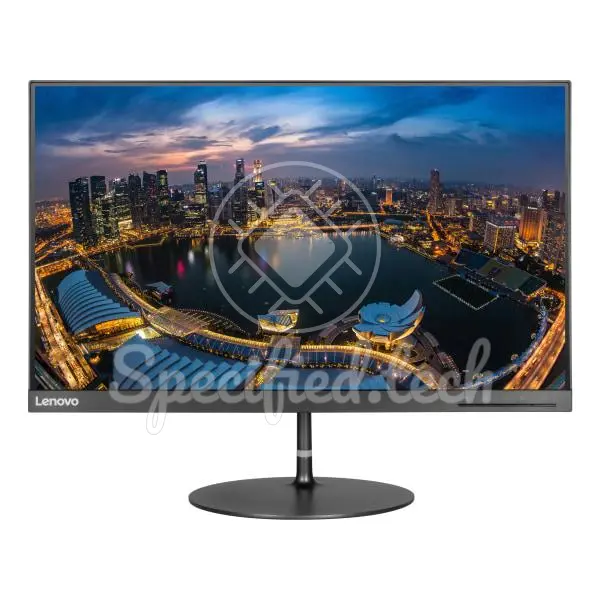
Today we will look at the monitor L24i from Lenovo from the year 2017. Within this article, we will first take a closer look at the most important feature of a monitor -the display-, then the design, and in the next section we will go into the features of the monitor. Of course, power consumption, certifications, connectivity and other important details will also be considered.
Display
23 inches ( 60.4 cm on the diagonal) offer sufficient space for texts in any office applications, for example. While classic CRT monitors were built with a screen ratio of 4:3, this monitor has a ratio of 1.778 : 1 (width to height). In addition to the aspect ratios and the specified screen diagonal, some enthusiasts may also be interested in the ratio between the monitor surface and the actual display. This ratio describes the general relationship between non-display and display. In other words, approximately 68.5 % of the front surface of the monitor consists of the display, while the rest consists of screen edges and cannot display an image. When setting up several monitors next to each other, it is advisable to give preference to models with the narrowest possible edges. The display is a IPS panel. The panel has a resolution of 1920 x 1080 px. The pixel density is 92 ppi. The pixel pitch is 0.275 mm. The continuous possible brightness specified by the manufacturer Lenovo is 250 nt. The panel is illuminated by W-LED. The built-in panel ensures stable color reproduction of the image, even at deviating viewing angles, by means of its 178 ° (horizontal) viewing angle. Lenovo promises stable color reproduction moreover within a 178 ° vertical angle. Vertically, however, the image renews at a minimum rate of 47 hz up to 63 hz. The minimum response time of the monitor is ms. The maximum response time of the monitor is ms. The display panel is Anti-glare/Matte.
Color representation
The panel has a bit depth of 8 per color channel, but what does that mean? The number of bits determines how many colors can be encoded for the individual pixels of the display. For an 8-bit panel, for example, this is 256 different colors (2^8 = 256). However, since we usually display three different colors per pixel at the same time, in theory about 16 million (256^3) different colors are possible by mixing the three pixels. A 10-bit panel could even display a billion colors. According to the manufacturer, the coverage of the NTSC 1953 color space is 72 %.
Contrast ratio
Contrast ratio is a common measurement used to represent the maximum relative differences in brightness between black and white. It describes the ability of a screen or projector to produce a high-contrast image and is the quotient of the maximum and minimum displayable luminance. The higher the values are away from each other, the stronger the quantitatively seen difference between black and white is set up, which in turn results in an improved image quality. This monitor from Lenovo has a static contrast ratio of 1000 : 1 , according to the manufacturer. In contrast to the static contrast ratio, the dynamic contrast ratio changes the brightness of the panel itself in addition to the difference measurement from black to white. In addition to the difference between the brightest and the darkest pixel, the backlight is thus changed. Since the brightness of the panel may not be able to be adjusted exactly to a single pixel, a so-called halo effect is possible. The value of 3000000 : 1 of dynamic contrast ratio for the monitor L24i cannot provide any information about the severity of the halo effect here. Therefore, it is more useful to compare the static contrast ratio.
HDR
The monitor supports all HDR modes listed here:
screen design
For the installation of the monitor, a space requirement of approximately 42.2 cm in height, 53.9 cm in width and 3.5 cm in depth is to be assumed.
If you want to place the monitor described here on the desk without a wall mount, you should allow for 42.2 x 53.9 x 21.9 cm (HxWxD) of space. The device weighs 3.26 kg with the stand in place. A wall mount should be designed for at least 2.8 kg to hold the L24i neatly and securely.
Rotate, tilt and swivel
The monitor from Lenovo cannot be rotated. The monitor cannot be swiveled. This feature could be retrofitted with a third-party stand. The monitor L24i can be tilted. The angle of inclination to the rear is 22. The monitor can be tilted forward by 5 degree.
Ports
The monitor can be connected via 1 VGA ports.
camera
This monitor does not have a camera.
Power consumption
The average consumption figure for L24i is 16.5 w. The maximum power consumption (peak) specified for this monitor is 8.5 w. In standby mode, the device consumes approximately 0.3 w. When switched off, on the other hand, the monitor consumes only 0.3 w. The monitor can be operated on a 110v power supply. The monitor can be operated on a 220v power supply. There are 1.2 amps specified. The power grid has to supply a frequency of 50 hz to 60 hz.
Environment
The maximum height at which the monitor may be operated, according to the manufacturer's specifications, is 5 km. During operation, the ambient temperature must not exceed 45 °C , to ensure full functionality. Below a temperature of 0 °C , the monitor from Lenovo should again not be used. The humidity must not exceed 80 percent. At least, however, 10 percent humidity. The monitor may be stored at a maximum humidity of 95 percent. The minimum humidity during storage should not fall below 5 percent. The maximum storage temperature should be according to Lenovo 60 °C. Minimal were given by Lenovo -20 °C. According to the manufacturer, the monitor may be stored at a maximum height of 12.192 km.

